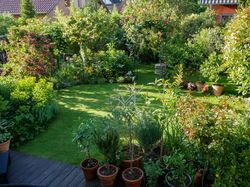 In the plant industry, we like to lean back comfortably and contentedly when we hear about demographic change. After all, it can't harm us...Older people are increasingly or at least steadily buying plants...but is this prejudice really true?
In the plant industry, we like to lean back comfortably and contentedly when we hear about demographic change. After all, it can't harm us...Older people are increasingly or at least steadily buying plants...but is this prejudice really true?
Demographic change – a reminder
The demographic change towards an ageing society in which the older population groups are in the majority is commonplace – but it tends to escape our notice. Do we really need to know this? Haven't we heard this time and time again? Part of this almost instinctive aversion to bad analytical news perhaps seems to be rooted in the fact that we are all getting older all the time...and that we perhaps don't like to hear about it.
Given these displacement mechanisms, the message of population change should be repeated here, and for Germany, the following is the case:
- In 1970, around 8% of the population was over 70 years old
- In 2023, just under 16% of the population is over 70 years old
- In 1970, just under 30% of the population was under 20 years old
- In 2023, approx. 18.5% of the population is under 20 years old
Which age groups buy how many plants?
At Lubera.com, we examined around 30,000 shopping baskets from 2023, from whose buyers we had age information. The result is actually not very surprising. In both Germany and Switzerland, it is the 50-60 year olds who account for the largest share of total plant sales. It can be assumed that the proportion of older buyers would tend to be even greater in the stationary plant trade.
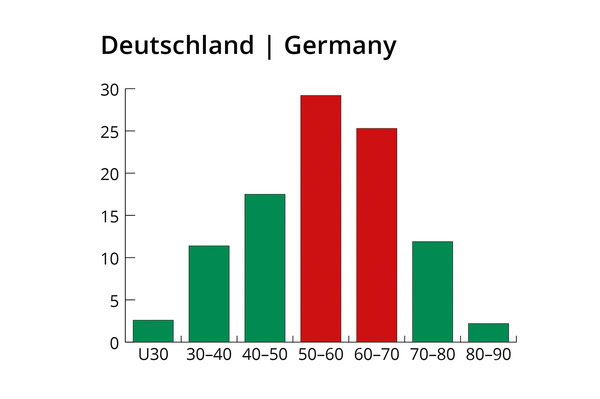
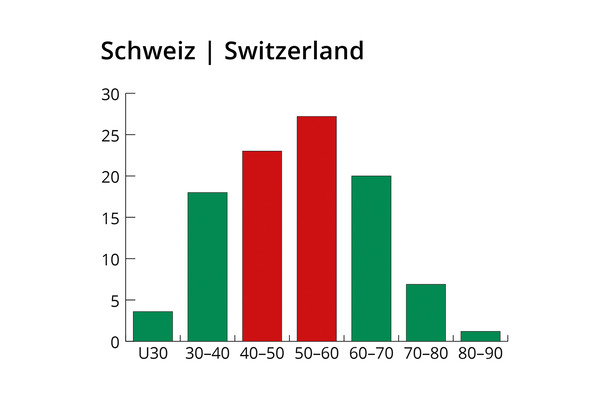
Figures: Sales distribution in Germany and Switzerland - broken down by age group
The curves are very similar in Germany and Switzerland. However, in Switzerland the younger age groups (30-50) are clearly more important than in Germany, while in Germany relatively more older people buy plants.
Overall, the results correspond to common sense expectations: very young people hardly ever buy plants, plant purchases begin when starting a family, with a larger apartment or with the construction of a house and culminate at the age of 50-60, when there is both enough space (garden) and enough time for gardening. Career goals are achieved or consolidated, the children leave home and are replaced by more gardening activities and/or pets...
Buying plants stops at 70...
Of course, it's nice and reassuring that 40-70 year olds buy around 70% of our plants. But we can't rest on our laurels: fewer and fewer people from the younger age groups are following suit and people over 70 stop buying plants quite abruptly. There is probably a feeling that there is too little future in which to invest in plants. There is less demand for fruit and vegetables, and there are also more and more infirmities that lead to the gardening hobby being curtailed. You could put it a little more bluntly: from the age of 70, buying plants stops and the horticulturist takes over with service and maintenance. For older customers and their mature gardens, the horticulturist looks after existing plantings and plants very few new ones...
Consequences for plant marketing
Life expectancy is continually increasing, so it is fair to ask whether the class of the most important plant buyers could be shifted upwards by 10 years. This will require special tailor-made offers that consciously address the situation of older gardeners:
- Larger ready-to-use plants instead of cheap young plants
- Suitable bundle offers, e.g. for planting a raised bed
- Combined offers for horticulture maintenance: seasonal plant sets, new fruit for next year, plants that can be harvested immediately
- Healthy nutrition from your own garden thanks to perennial vegetables
Nevertheless, it is rather unlikely to attract many new customers from the same age group after 70; either they are gardening at this age – or we will probably never get them interested in gardening again.
In contrast, attracting younger customers between the ages of 25 and 40 seems much more promising and sustainable. The effort invested here also has positive effects for much longer. What measures could appeal to younger female customers? We can only formulate a few general ideas here:
- Address young potential gardeners where they are – social networks
- Easy gardening – breaking down barriers
- Guarantees of success
- Ready-made offers
- Bundles with price advantages
- Quick guides
Attracting young female customers with edible plants
Especially during the COVID-19 pandemic, houseplants have become the most important plant group for very young plant buyers (20-30 years old). It remains to be seen whether this trend will continue, but of course, it fits in well with the life situation of younger people, who rarely have a fully grown garden.
Almost unnoticed, edible plants have become the favourites of younger buyers, and we at Lubera.com were surprised by the results ourselves:
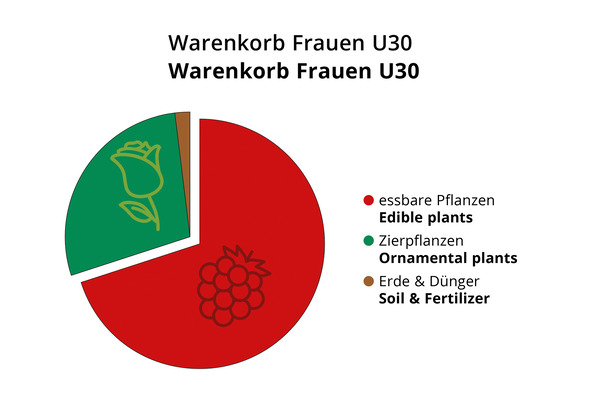
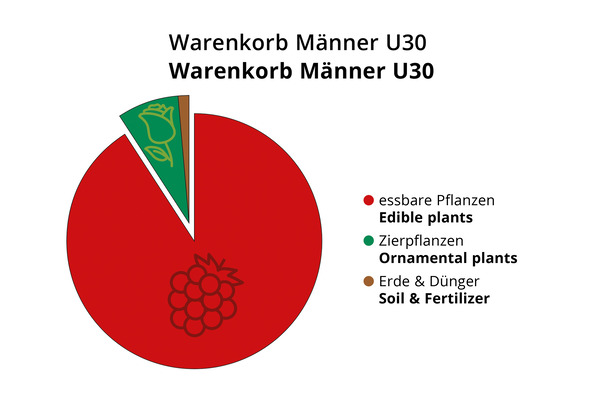
Figures: Average shopping baskets for women and men in the ' under 30' age group - the different weighting of edible and ornamental plants is clearly recognisable
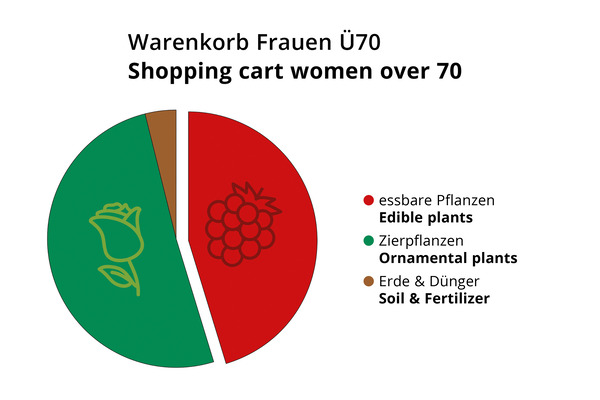

Figures: Average shopping baskets for women and men in the 'over 70s' age group - the differences between edible plants and ornamental plants become even clearer here
Of course, edible plants will be somewhat overrated here among Lubera buyers, as fruit, berries and vegetables are among the core competencies of our sister company Lubera.com. Nevertheless, 4000 items of the 6000 plants on offer at Lubera are also ornamental plants (and not edible). The trend, which extends across all age groups, is very clear: edible plants are much more important for younger people than for older plant buyers. The reverse conclusion is also permissible, even obvious: if you want to attract younger plant buyers, you need to offer more edible plants creatively. However, this also includes very simple instructions, as unlike 50 years ago, we can no longer rely on basic gardening knowledge being taught at home by our mothers. And this includes special offers for balconies and terraces, perhaps even for indoor production...
Significantly more female gardeners than male gardeners
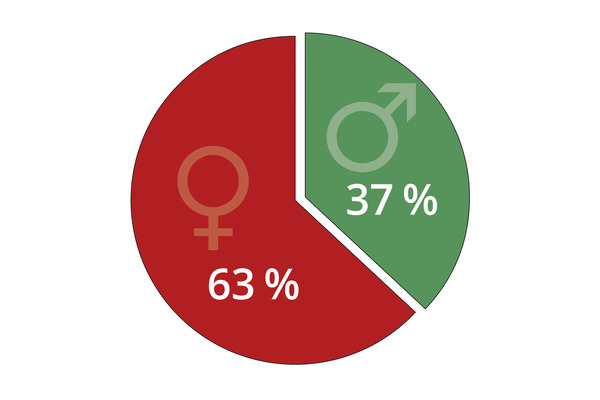
Figure: general distribution of sales between women and men, across all age groups
By the way, one last thing that should never be forgotten: at Lubera, almost 2/3 of plant buyers are women, and only a good third are men...However: according to our data from Lubera.com, men tend to buy edible plants even more than women...
